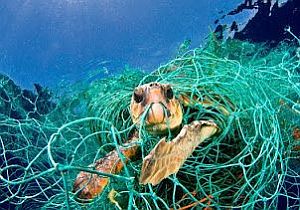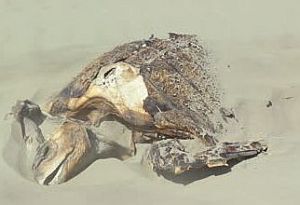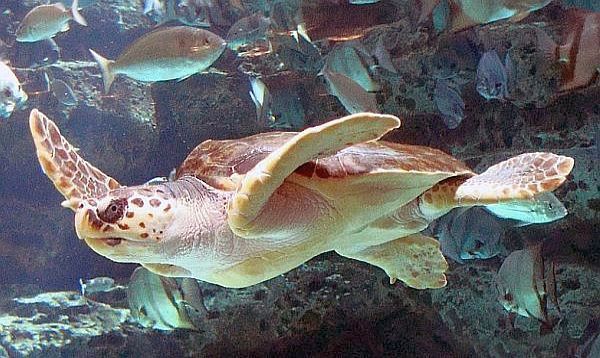One thing definitely hasn't changed since ocean scientist Wallace Nichols began studying loggerhead sea turtles in Mexico's Baja California more than 20 years ago: North Pacific sea turtles are dying.
And the main culprit - bycatch - is easy to spot, he said.
Thousands of dead sea turtles have washed ashore over the years on a small stretch of beach in Baja California. Last year, Mexican wildlife law enforcement reported 438 of the animals as stranded and dead over a two-month period. This year, 705 dead loggerheads were reported by officials in that same amount of time. Scientists say the official numbers are far below the reality.
The turtles, known for their powerful jaws and large heads, live in waters from the Gulf of Mexico to the Mediterranean Sea. But of the nine loggerhead populations found around the world - all of which are considered endangered by the International Union for Conservation of Nature - one is considered most threatened by bycatch: the North Pacific population.
The turtles begin their lives in Japan before swimming across the Pacific to feed off the western coasts of Mexico and the United States. They eventually go back across the ocean again to nest.
During the period between their more than 7,500-mile migrations, the turtles hit a potential snag, said Bryan Wallace, chief scientist at the Oceanic Society. Those that end up near the Baja California Sur area are at a higher risk of being accidentally caught by fishermen because the small area is home to a relatively large amount of fishing gear.
"It's a perfect storm situation," said Wallace, who earlier this year published a peer-reviewed study on global bycatch rates for loggerheads.
Nichols, the scientist who has studied the situation for years, noted that only a small number of boats and fishermen are causing the damage. He and other researchers once believed that if they could reach out to the locals and work with the Mexican government, they would be able to fix the problem.
The effort seemed to work for a while. Shortly after arriving in Baja California in the 1990s, he helped establish Grupo Tortuguero, a group that taught locals about sea turtle conservation. Eventually, one of Nichols' students moved to the area and led the grass-roots campaign to educate the community and improve fishing gear.
 |
"It's all been a slow grind, but we thought we were making progress," Nichols said.
Then two years ago, things started to fall apart when collaboration broke down with the Mexican government. According to Nichols, a smear campaign began to discredit all nonprofit organizations around the country, especially those that focused on environmental issues. That move resulted in attacks against the loggerhead conservation effort, he said.
Though the issues began before current Mexican President Enrique Peņa Nieto took office, Alejandro Olivera of the Mexican Center for Environmental Rights places some of the blame on the current administration.
"While we spent several years meeting with the past administration to solve the problem, this current administration has decided to deny it," he said. "It was a huge step back."
Mexico's "National Commission of Natural Protected Areas" and "National Commission of Aquaculture and Fishing" did not respond to requests for comment.
Enviros Call for US Trade Sanctions
US conservationists find the situation so alarming that they have petitioned the federal government to examine the problem and to enforce trade sanctions against Mexico until protective measures for the creatures are put in place.
"This turtle population crosses the border between Mexico and the United States," said Sarah Uhlemann, an attorney with the Center for Biological Diversity, which filed the petitions this year with the National Oceanic and Atmospheric Administration. "This animal is one of our own. ... It's time for Mexico to step up and take responsibility."
Tougher regulations in Hawaii have resulted in less bycatch of the same sea turtles that end up in Baja California, scientists said. In Hawaii, a fishery can catch only 16 turtles - alive or dead - per season. If a fishery exceeds that number, it must shut down for the rest of the year.
Conservationists say that if similar rules were enforced in Mexico, more of the animals could be saved.
The first petition urges the National Oceanic and Atmospheric Administration's National Marine Fisheries Service to examine the issue under a provision of the Magnuson-Stevens Fishery Conservation and Management Act. The Moratorium Protection Act requires the agency to examine reports of illegal, unreported, or unregulated fishing or bycatch by other countries, said Jean-Pierre Ple, deputy director of the National Marine Fisheries Service (NMFS) Office of International Affairs.
Under the petition, the agency is looking into the high turtle bycatch rate in Baja California. It will spend the next two years consulting with the Mexican government to create regulations aimed at boosting the loggerhead population.
Mexico is the first country to be examined under this statute, so no precedent exists for what happens next, Ple said. The process could go one of two ways. If, at the end of the consultation process, NMFS decides Mexico has developed adequate regulations, the country will receive a positive rating in the agency's next international fisheries management report.
But if Mexico fails to meet the higher standards, NMFS, through the Commerce secretary, can recommend to the president that he impose prohibitions on Mexican fishing vessels and fishery products.
 |
"These are very serious demands with very serious consequences," said Uhlemann.
The conservationists also filed a legal petition under the Pelly Amendment to the Fishermen's Protective Act. Under that law, the fisheries service must examine the issue because of the Inter-American Convention for the Protection and Conservation of Sea Turtles international agreement.
NMFS is evaluating that petition and collecting information related to it, planning a "timely" decision on the request.
Though the examination by the agency has no deadline, the potential result is similar to the ones under Magnuson-Stevens: If NMFS determines that Mexico has violated the international treaty and has refused to change its rules, the Commerce secretary can recommend that the president institute a ban on Mexican fishery products.
The Pelly Amendment, unlike the Magnuson-Stevens provision, has been used before, but no trade sanctions have ever been imposed because the problems have been resolved in diplomatic situations, said Alexis Gutierrez of NMFS's Office of Protected Resources.
Nichols views a potential fishery ban as a worst-case scenario. Despite the setbacks, he still believes the best way to help the loggerheads is to encourage better enforcement from Mexican officials and to continue working with local communities to promote turtle-safe gear and fishing practices.
"Science doesn't save sea turtles. Even laws don't save sea turtles," Nichols said. "People do."
Original Story


